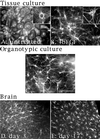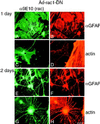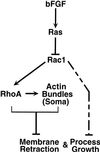Ras family GTPases control growth of astrocyte processes
- PMID: 10233170
- PMCID: PMC30489
- DOI: 10.1091/mbc.10.5.1665
Ras family GTPases control growth of astrocyte processes
Abstract
Astrocytes in neuron-free cultures typically lack processes, although they are highly process-bearing in vivo. We show that basic fibroblast growth factor (bFGF) induces cultured astrocytes to grow processes and that Ras family GTPases mediate these morphological changes. Activated alleles of rac1 and rhoA blocked and reversed bFGF effects when introduced into astrocytes in dissociated culture and in brain slices using recombinant adenoviruses. By contrast, dominant negative (DN) alleles of both GTPases mimicked bFGF effects. A DN allele of Ha-ras blocked bFGF effects but not those of Rac1-DN or RhoA-DN. Our results show that bFGF acting through c-Ha-Ras inhibits endogenous Rac1 and RhoA GTPases thereby triggering astrocyte process growth, and they provide evidence for the regulation of this cascade in vivo by a yet undetermined neuron-derived factor.
Figures










Similar articles
-
L-glutamate activates RhoA GTPase leading to suppression of astrocyte stellation.Eur J Neurosci. 2006 Apr;23(8):1977-87. doi: 10.1111/j.1460-9568.2006.04728.x. Eur J Neurosci. 2006. PMID: 16630046
-
Astrogliosis in culture. IV. Effects of basic fibroblast growth factor.J Neurosci Res. 1995 Feb 15;40(3):359-70. doi: 10.1002/jnr.490400310. J Neurosci Res. 1995. PMID: 7745630
-
Possible involvement of the inactivation of the Rho-Rho-kinase pathway in oncogenic Ras-induced transformation.Oncogene. 1998 Dec 3;17(22):2863-71. doi: 10.1038/sj.onc.1202213. Oncogene. 1998. PMID: 9879992
-
Bacterial cytotoxins target Rho GTPases.Naturwissenschaften. 1998 Jun;85(6):253-61. doi: 10.1007/s001140050495. Naturwissenschaften. 1998. PMID: 9686394 Review.
-
Rho family proteins and Ras transformation: the RHOad less traveled gets congested.Oncogene. 1998 Sep 17;17(11 Reviews):1415-38. doi: 10.1038/sj.onc.1202181. Oncogene. 1998. PMID: 9779988 Review.
Cited by
-
The indolinone MAZ51 induces cell rounding and G2/M cell cycle arrest in glioma cells without the inhibition of VEGFR-3 phosphorylation: involvement of the RhoA and Akt/GSK3β signaling pathways.PLoS One. 2014 Sep 30;9(9):e109055. doi: 10.1371/journal.pone.0109055. eCollection 2014. PLoS One. 2014. PMID: 25268128 Free PMC article.
-
Dual observation of the ATP-evoked small GTPase activation and Ca2+ transient in astrocytes using a dark red fluorescent protein.Sci Rep. 2016 Dec 22;6:39564. doi: 10.1038/srep39564. Sci Rep. 2016. PMID: 28004840 Free PMC article.
-
Sphingosine-1-phosphate signaling regulates lamellipodia localization of cortactin complexes in endothelial cells.Histochem Cell Biol. 2006 Sep;126(3):297-304. doi: 10.1007/s00418-006-0143-z. Epub 2006 Jan 14. Histochem Cell Biol. 2006. PMID: 16416022
-
Silactins and Structural Diversity of Biosilica in Sponges.Biomimetics (Basel). 2024 Jun 27;9(7):393. doi: 10.3390/biomimetics9070393. Biomimetics (Basel). 2024. PMID: 39056834 Free PMC article.
-
GluN3A: an NMDA receptor subunit with exquisite properties and functions.Neural Plast. 2013;2013:145387. doi: 10.1155/2013/145387. Epub 2013 Dec 9. Neural Plast. 2013. PMID: 24386575 Free PMC article. Review.
References
-
- Bignami A, Eng LF, Dahl D, Uyeda CT. Localization of the glial fibrillary acidic protein in astrocytes by immunofluorescence. Brain Res. 1972;43:429–435. - PubMed
-
- Cameron RS, Rakic P. Glial cell lineage in the cerebral cortex: a review and synthesis. Glia. 1991;4:124–137. - PubMed
-
- Chen SY, Huff SY, Lai CC, Der CJ, Powers S. Ras-15A protein shares highly similar dominant-negative biological properties with Ras-17N and forms a stable, guanine-nucleotide resistant complex with CDC25 exchange factor. Oncogene. 1994;9:2691–2698. - PubMed
Publication types
MeSH terms
Substances
Grants and funding
LinkOut - more resources
Full Text Sources
Research Materials

